The photos above show sparks from my ignition coil setup with perhaps 10
sparks per second. This single brief impulse means that there is not a
second spark going down the heated channel of the first. You can
see gaps in the spark channel which is viewed here end on and magnified.
Sometimes there is a hazy glow in the gap but often not.
Here is another example with the magnified view. The left electrode is
negative in this DC spark taken through my 300 kV diode so this is a
negative side effect.
The photo above shows the Crooke's space in a neon tube at reduced pressure.
So there is a precedence for gaps in the spark channel.
Sparks don't have uniform brightness as well which may be a related effect. About one third of the
negative end of the spark is brighter as
well. Although this is a spark from a coil it is being driven by a DC
pulse and can be regarded as polarized.
I therefore suspect that this is a feature of the spark, presumably
analogous to the Crooke's spaces seen in lower pressure discharges.
Since you often see this with Tesla coils maybe the discharge is polarized
there too.
Above shows the bright area in the spark seen in a Tesla coil discharge.
Generally seen when sparks are low power and purple rather than hot white.
Sort of suggests that a Tesla coil sparks that only just connect are from a
primarily positive discharge from the toroid.
The spark above is viewed in two directions at the same time using a mirror
at 90 degrees angle. 3 of the 5 sparks have gaps and they are present in
both views. The negative end is brighter as well.

High speed spark photography 2006

 (click to enlarge)
(click to enlarge)
Now this is interesting. This is taken through a rotating mirror. I joined a
first surface laser mirror to one of my motors. Running at 2250 RPM and with
the spark 16 cm away the radial velocity of the spark is 37 m/s. With the
image being only the negative 2 cm of a total 7 cm spark width, the vertical
distance of the photo is 500 us. So you should see events in the
region of 10 us easily enough. There doesn't seem to be any structure at
that level around the discontinuity.
 (click to enlarge)
(click to enlarge)
The Tesla coil above is my
junk coil running on half of a 12 kV 30 mA NST. It has a few ceramic
caps and a 3 segment static gap. Primary is 15 turns and secondary is 260
turns in 11 inches. There is usually no toroid but I used one to intensify
the sparks by putting an old tin on top. The gap is only about 2 cm to all
fit in the mirror view. You can just see the spark in the mirror in
this photo.
Of course, with each spark lasting microseconds or less it becomes harder to
catch a spark in the mirror. Even with 2 second exposures and the spark
firing at perhaps 20 Hz you only get a spark in view occasionally. It
should be easy to increase the resolution by a factor of 10 - 20 to see
events at microsecond level. It may take many minutes of exposure to get a
spark though.
This would be of great interest to Tesla coiling to get sparks seen on that
time frame.
Note that this is not a true high speed photograph. Vertical movement of the
spark on the image may be due to irregularity of the spark or due to events
happening in time. Multiple spark channels should show up well or stepped
leaders perhaps.


 (click to enlarge)
(click to enlarge)
The left photo shows a single spark and the centre photo shows
multiple sparks captured with a longer exposure.
Mirror to spark distance is 38 cm which means that the image moves at about
100 m/s. The picture represents about 2 cm width and 4 cm height i.e.
vertical scale is 40 us. (just over 100 ns/pixel). The right photo
shows a view of a LED being flashed at 100 kHz hence the distance between
each LED is10 us.
So what do we see and how to interpret it?
There is a ladder of sparks with each spark being fairly discrete and
without any obvious parallel sparks. All sparks seem complete and there are
no discontinuities. Almost all sparks are bright at the ends but less bright
in the centre third. This also corresponds with what you see when it is
running. I am not sure what it means, however, if each spark is a single
cycle then the negative one third may brighter each half cycle, leaving the
centre dim.


The left photo shows a Royer ZVS circuit firing a rewound
inverter MOT transformer to give perhaps 2 kV at 15 kHz. It wasn't bright
enough to show so I later added a diode, resistor and .06uF mica cap to give
a brighter spark which was rather irregular due to the low firing voltage. The
right photo is 100 vertical
pixels = 10us showing 3 sparks of less then 1us duration, which appear to
deviate from a vertical line. Going back to the setup photo, you can see
that one of the electrodes is vibrating changing the spark position.
The 3 sparks suggest that there is a resonance at about 10 us period - 100 kHz
due to the .06 uF cap and the effective series inductance of the cap itself
plus the two 8 inch crocodile clip leads. As you can judge by the
pixilation (automatically smoothed by the software) plus the noise, the
camera is being pushed to the limit. Very small sparks still seem to be
point events. Hopefully a 2 foot TC spark will have more structure.
To see speed of light events I would need to have 500 foot events which
would be 1us. In fact it would not be too hard to bounce a laser over a path
this length to show the speed of light. Hmmm... I have a corner cube prism
and two eight inch parallel first surface mirrors. Add a beam splitter or
two, line it all up and go. Ohh, and it needs to have picosecond switching.
Did I mention that? Maybe
my scanner Hex mirror assembly could rotate the laser beam to give fast
enough effective switching. Head is starting to hurt here.
High speed Tesla spark photography 2006
Here are some Tesla shots with the rotating mirror setup as above. The
TC is my 4 inch one. It was set up for 4 then 6 inch sparks between pointed
electrodes to a grounded object. Power was 4 MOT's and current draw about
10A 250 V so enough to have a reasonable power arc rise in the centre if it
got going. The distance from camera lens to mirror was 30 cm and from mirror
to TC 140 cm.

 (click to enlarge)
(click to enlarge)
The left photo shows the the setup (taken with my older camera) and
shows the TC at left. The camera (center) picks up the image from the
rotating mirror on the right. The right
photo shows the TC running with spark just behind my shoulder.

 (click to enlarge)
(click to enlarge)
The left photo shows the reversed image through the rotating mirror
(stationary for this photo) showing the toroid on the left. The right
photo shows the single spark with a series of up to 5 parallel sparks.
Each space between sparks is 50 pixels which is 5 us period or 200 kHz. This
implies a 100kHz waveform if there are two sparks per sine wave. Seems in
the ballpark for the running frequency of this coil.
Note that this is not the banjo effect seen on a
windy day which is just the spark gap firing rate of 100/120Hz for a synch
gap (or 1100Hz with my fast asynchronous gap which was running flat out as I
didn't have a third variac setup). This is 100 - 1000 times faster.
Very high speed observations of spark growth can be made with
streak cameras
which use a photomultiplier tube to displace and magnify the image. It is
about 3 orders of magnitude faster than what I am doing. It gives
propagation rates of spark leaders of 10^9 cm/sec (approx 1/30 of speed of
light) whereas I can only achieve 10^4 cm/sec.
Still, I was never expecting to be able to see things like that with
equipment found around the home.
On the other hand, streamer growth has structure on very slow timescales
which is why they are interesting to look at. In short, you can see them
move so there are things happening at all sorts of timeframes from
nanoseconds to seconds. Streamer brightness is much lower however but should
register some interesting images.
Interpretation of streak camera stuff is easy if sparks are a straight line
but become difficult if angled or branched so a blurred mess is a possible
outcome when I try this with streamers.
I'm not sure how "useful" this will be but I hope to get some streamer data
sometime.
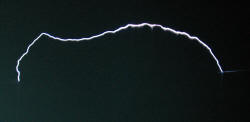
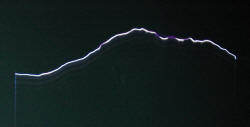 (click to enlarge)
(click to enlarge)
The left photo shows an arc with no following 100 kHz ring down like
in the last photo. The right
photo shows a bright arc with faint ring down.

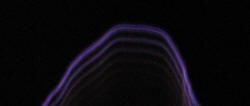 (click to enlarge)
(click to enlarge)
The left photo shows gaps in the bright white arc channel filled with
faint purple arcs. The right
photo shows detail of the initial spark which has a clear central
channel on the enlarged view.
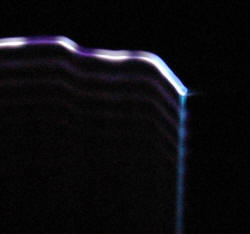
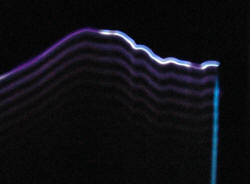
 (click to enlarge)
(click to enlarge)
The left photo shows the ionization around the stainless steel
electrode which does glow red hot at the end of a run although that is too
faint to see. The center
photo shows that the ionization is sometimes delayed by 5 us after the
initial spark strikes. The right photo shows an unusual streak that I suspect is the spark channel
hitting a dust mote and burning it up.
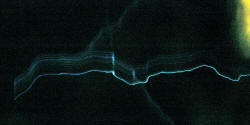
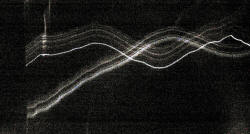

(click to enlarge)
The left photo shows a streamer which is about 12 inches of an 18
inch spark from the toroid side on the left. I was throttling the variac
back to try to just get streamers and few hits. It is quite different.
Time axis is downward. The initial streamer sparks (the top one) can be
broken into perhaps 6 consecutive channels (5us apart = 2 pulses per
100kHz). Although it is difficult to be sure, only the last one makes it
across the screen then a 10us gap then the main arc hits. Interestingly
there is no ring down on the main arc, however the distances are greater and
intensity is down. The center
photo shows two different streamers which are unrelated but overlapping.
It shows the variability in intensity of subsequent spark channels and the
gap before the main arc forms. Perhaps this is a harmonic effect and
the spark channel is actually of greater energy than the channel before
The right photo shows the streamer ring up sparks of as many as 8
sparks in a row.
I guess the new information from the rotating mirror stuff is that streamers
enlarge with successive cycles and ring up leading to a spark that connects.
Sparks that connect (often) have a ring down. Not really unexpected from the
CRO pics but nice to see it directly. So streamers ring up and sparks ring
down - easy to remember.
High speed Tesla spark photography - LED polarity, current indicator
2006


 (click to enlarge)
(click to enlarge)
The left photo shows the spark with some red lights on the right.
These indicate polarity and the LED closest to the spark indicates a
negative discharge from the toroid on the left. Next the right LED
lights up with the positive cycle and so on. This shows polarity for
more cycles than the eye can readily see from the photo. The center
photo shows detail of the LED's. The right photo
shows the same photo as the center one but with a full view also with a negative leader.
 (click to enlarge)
(click to enlarge)
The photo above shows the red LED's in circuit. The spark goes directly to
one end and the other end is grounded. There are two 10 ohm resistors
and the LED's are connected in parallel but with opposite polarity. These
values are determined by experiment and are strange but it works. For
example you can't light the LED's with DC unless you put in 0.4 A which
dissipates 4 W and burns up the resistor which has a 1 W rating. The
LED's are bright in action and since they are turned on for only a few
microseconds at a time in with a low overall duty cycle, must have a very
high output during this time.



(click to enlarge)
The left photo above shows a single LED being remarkably tolerant to
high voltage impulses. The center photo shows the circuit diagram of
the current meter and the right photo shows it in action with
ignition coil sparks. The current range is a nominal .002 A to 20A and has a
reverse LED as well.
All this is hard on LED's which don't last long. LED's can die by degrees as
below.
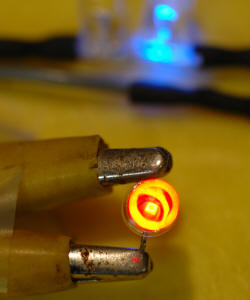


(click
to enlarge)
The left photo above shows a normal red LED driven by 6 VAC via a 1 k
resistor plus antiparallel green and blue LEDs which is my wired test setup
(very handy). Note the LED die (light emitting square in the centre of the
LED. Only the blue LED lights as current only passes in one direction. The centre photo shows
a partially dead LED where the square die has a non functioning area.
In addition the LED is not bright and it conducts in both directions as both
green and blue LED's light up. The right photo
shows a partially dead LED where the square die is still normal but the LED
is not bright and it also conducts in both directions as both green and blue
LED's light up.
This is the second reincarnation of the current meter.


 (click
to enlarge)
(click
to enlarge)
The left photo above shows the circuit diagram. Xenon light is first
in series because I thought that would be most sensitive. The main current
path is through a 2W 10 ohm resistor shunted by a neon. What I want to do is
to remove the nastiness of the spikes then use a 1MHz low pass filter with
windings on a ferrite core and a ceramic cap. After that a TVS should be
able to work to limit voltages to +/- 30V and the LED's will do the rest.
The LED array should read in decades but I probably should put individual
shunt resistors rather than an overall one. This needs to be redesigned as
it won't work as intended and I need to give this some more thought. The centre photo shows
the xenon in action with the lights in the same horizontal line. The right photo
shows the rear view with the mostly covered neon on the left and two
indicator diodes on the right which should be running within ratings and
shouldn't blow but won't be very bright either.
High speed Tesla spark photography
- large mirror
2006
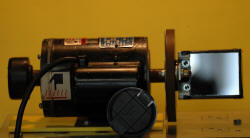 (click to enlarge)
(click to enlarge)
Here is the same motor but with a bigger mirror of 7 cm square, more compatible with the
size of my camera and it shows the lens cap for comparison.


 (click to enlarge)
(click to enlarge)
The left photo shows the view of a 25 inch spark with LED monitors on
both toroid and ground ends with the rotating mirror stopped. The centre photo shows
a negative strike from the toroid end to ground with the appropriate
polarity being mirrored at the other terminal with identical ring down.
It is not always like this and the toroid end in particular often has less
ring down than the ground. The right photo
shows a streamer with a ring up and after several rings it strikes. I am not
sure if the bright spark above it is related. It is possible that a strike
had a ring down but restarted as a streamer down a different channel
which rung up until it struck again.


 (click
to enlarge)
(click
to enlarge)
The left photo shows a streamer from the toroid and a straight
streamer from the other side. Unfortunately this was a strike that bypassed
my LED and went directly to the grounded ladder. It was only
later that I appreciated that the three groups of LED flashes was showing a
harmonic frequency influencing the output. The centre photo shows
a streamer with a clear ringing which fades. The right photo
shows a spark (bright horizontal) with ring down, superimposed on a diagonal streamer
with a ring up.
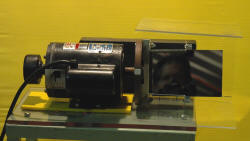
 (click to enlarge)
(click to enlarge)
The photo above shows the new larger mirror measuring 10 x 15 cm. This is a
higher quality rear silvered mirror with no visible distortion on viewing at
a distance. It is well centered but moves a fearsome amount of air and has
some vibration at 3000 RPM (250 VAC) but 2000 RPM (85 VAC)seems comfortable.
The reduced revs should be countered by the much clearer and wider view.
Still needs to be tested in use though. It is a big mirror to spin
fast but the aluminium supports seem to hold it firmly without adding too
much weight or obstructing the view.

 (click to enlarge)
(click to enlarge)
The left photo shows the much sharper pictures which reduce the spark
to about 3 pixels width. At about 100 pixels per inch this is
about .03 inch or about 1 mm. This is a daytime shot so contrast is
low. The right photo
shows detail which has been left pixilated showing how narrow the focus is.
This is from 8 feet showing each pixel of 1/100 th inch. It also shows
two parallel artifacts. I think these are from mirror stresses giving
aberration from a flat surface. Alternatively, they may be internal mirror
reflections from the rear silvered mirror but these should only be on one
side if that was the case. Fortunately they are horizontally displaced
and can be differentiated from vertical displacement with spark ring down.
Now that the camera is getting a full lens view of the whole spark it should
achieve close to its optimum performance. Seemed to get worse during
the day so needs a new design with no stress and epoxied in place. This was
a daytime shot and in retrospect was probably sharper than the night shots
as it was f18 and 1/10 sec. Night shots were f3.5 and longer duration.
Possibly a proper optically flat first surface is needed.
At a motor speed of 2160 RPM and camera distance of 8 feet, the scan speed
is 900 feet per second = 300 m/s. This is around 1,000,000 pixels per
second. So 1 pixel per microsecond which is a nice round figure. Hence
the ring down sparks should be 5 pixels apart at 200 kHz per half cycle which
is 10 times slower than some of the photos above. However this is with a
full 2 foot spark in view. If I change lenses and distances this can
be spread out much further but I could not fit the full 2 feet width in
view.

 (click to enlarge)
(click to enlarge)
The left photo shows the negative LED firing well and repeatedly, but
I guess this was due to some asymmetry in the LED's as it seems to be happening
on one day. Makes you wonder though as I was using slow rotary spark gap
(ARSG) rates
today. The alternative explanation is of another harmonic frequency being
involved. The right photo shows a current meter but I
have had problems with it. Possibly overvolting the metal film 1/8 W
resistors. Certainly looks like one resistor is open circuit here. They
should fire at 0.01, 0.1, 1 and 10 amps respectively left to right but the 1
amp LED is firing too readily. The 100 A and above LED's never fired. (but
did with a capacitor on a rectified ignition coil setup).
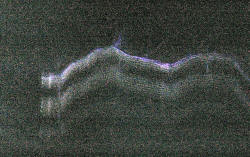
 (click to enlarge)
(click to enlarge)
The left photo shows a second and possibly third group of streamers
following. The right photo shows the addition of a spark arrestor and
a disposable camera xenon flash in series with unprotected LED's. I
got this interesting but blurred streamer shot showing a remarkable 6
streamer groups that the camera and LED's weren't picking up. Seems like
there is a another frequency superimposed of perhaps 8-10 kHz. I presume that
this is the difference between primary and secondary resonances (the
"notch"). I am running the Tesla coil a bit out of tune still so that may account for
that. It could actually explain a row of negative only ring down sparks as
well.
I think the spark gap arrestor is the most sensitive at picking up streamer
currents and is more of a point source than the Xenon.

 (click to enlarge)
(click to enlarge)
The left photo shows a streamer branch with only alternate streamers
progressing from left to right after the branch. This suggests some
polarity effect at the time e.g. negative goes to the upright branch and
positive continues on. The right photo
shows detail of a streamer that connects during the time when the harmonic
is resulting in low voltages, hence the current is low and the spark is not
strong. As the voltage picks up, there is enough energy for a second strike.
The left LED's are not functioning properly but do indicate the first group
of firings then a gap and then a second lot starting. I also have the
spark arrestor running here which is the blue streak between the LED's and
the spark.
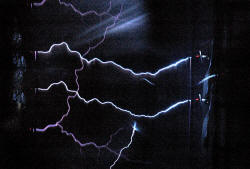
 (click to enlarge
- 1Mb)
(click to enlarge
- 1Mb)
The left photo shows a 4 foot streamer branch and multiple spark
views. The right photo also shows multiple views of a 3 foot spark
burning up the resistor to the LED's.
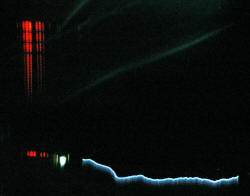
 (click to enlarge)
(click to enlarge)
The left photo shows the second version of the current meter.
Just regard it as a sensitive single indicator LED at present. A spark
recorded relatively brief activity only but a nearly invisible streamer gave
a prolonged ring. I did wonder if this was due to ringing from the 1 MHz low
pass filter but in other shots the Xenon is firing for a good proportion of
these so that resonance seems unlikely. The ring frequency of the filter
should be ten times faster in any event.
The right photo shows the Xenon (blue region on right) firing for the
first three groups.
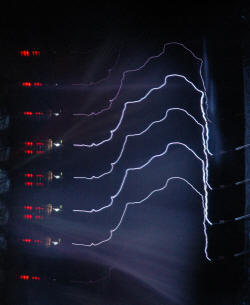 (click to enlarge)
(click to enlarge)
The photo above shows a view with the motor running at a slow 200 RPM
(instead of 2000 RPM). It shows the sequence of strikes down the same
channel. Spacing between sparks is about 1.5 ms which corresponds to
about 600 Hz which is about right for my spark gap at about half speed. What
you are seeing therefore is sparks rising in one half cycle of 50 Hz mains
with the intensity increasing and then decreasing.
Terry Fritz has done a lot of work on streak cameras as well with excellent
results. His pictures and the race to develop this is detailed in this
thread in the
4HV
forum.

Future plans
More sparks of course. Hopefully some Guinness World Record stuff.